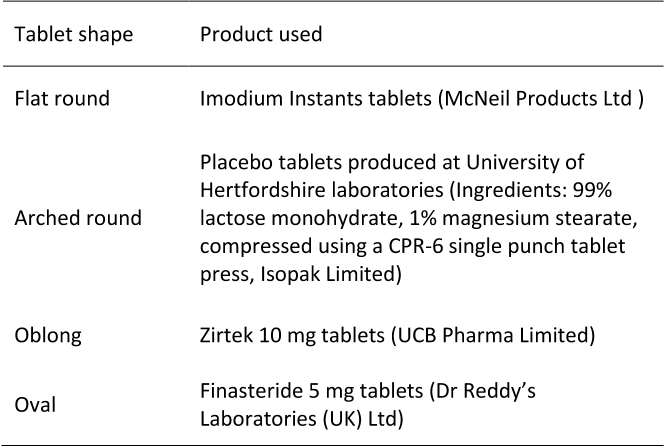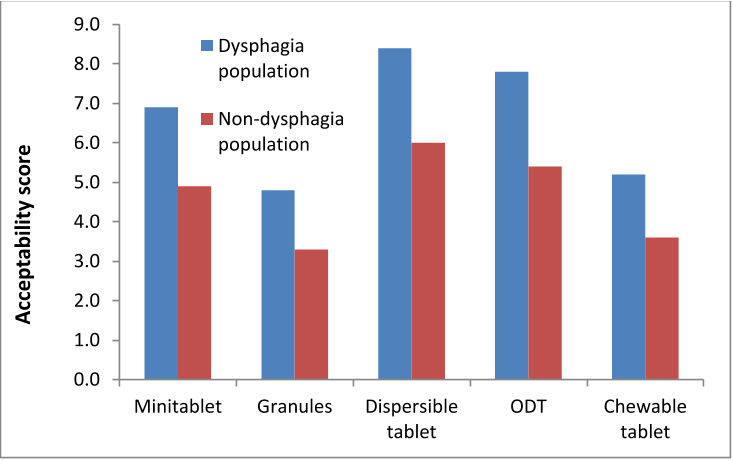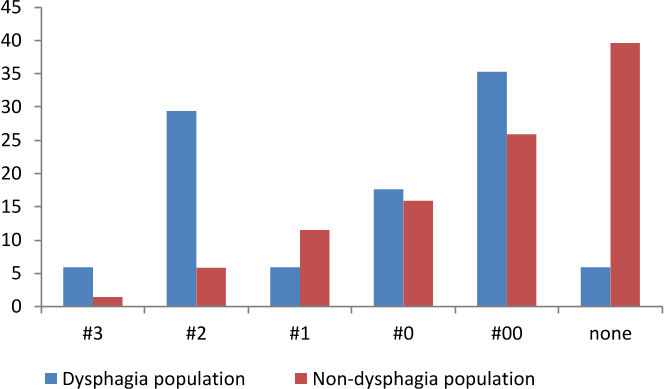Acceptability of oral solid medicines in older adults with and without dysphagia: A nested pilot validation questionnaire based observational study
Summary (2 min read)
1. Introduction
- Previous knowledge on these effects has been demonstrated in healthy young subjects; however, this remains unclear in older people especially those with existing swallowing difficulties.
- The type of formulation might be another factor affecting the ability and willingness of older patients to take their medicines.
- A number of solid oral dosage forms that are "easier to swallow" than tablets and capsules have been made available in recent years including orally disintegrating tablets (ODTs), dispersible tablets, mini-tablets and multi-particulates .
- For older patients who cannot swallow tablets, the availability of these formulations could be beneficial.
2.2 Administration of the Sydney Swallow Questionnaire (SSQ)
- The SSQ is a validated questinnarie and composed of 17 questions assessing oral and pharyngeal swallowing function with responses entered onto a 101 mm visual analog scale except for question 12 (R. C. Dwivedi et al., 2010; K. L. Wallace et al., 2000) .
- The SSQ was administered to the participants during an interview which took place in the private consultation room in the pharmacy.
- The participant placed a mark on the horizontal line of the visual analog scale.
- The first millimeter of the line was disregarded and a score of 0-100 was calculated by measuring the distance from the center of the mark to the first millimeter of the line for each question.
- The maximum possible total score for the SSQ was 1700, with higher score indicating greater severity of swallowing dysfunction.
2.3 Pilot of the Medicines Acceptability Questionnaire (MAQ)
- The content/face validity of the MAQ was assessed by two experts in the field acting as respondents.
- Cronbach's alpha test was conducted to evaluate the level of reliability and internal consistency using the Statistical Package of the Social Sciences (SPSS) version 22.0 (IBM Corp., Armonk, NY, USA).
- Cronbach's alpha scores of 0.7 or above were deemed as acceptable according to Nunnally and Bernstein (J. Nunnally and L. Bernstein, 1994) .
- The MAQ was administered to the participants during the interview together with the SSQ.
- The interviews were conducted by two of the authors (AG and JB).
2.4 Data analysis
- Data analysis was performed using the Statistical Package of the Social Sciences (SPSS) version 22.0 (IBM Corp., Armonk, NY, USA).
- The results are reported as mean ± standard deviation (SD).
- Spearman's nonparametric correlation was used to identify the presence of significant correlations between total SSQ score and age of participants or number of solid oral medicines taken daily.
- The Mann-Whitney U test was conducted to assess links between gender of participants and total SSQ score, and comparing the means of participants' selfperceived health status between the dysphagia and non-dysphagia group.
- Chi-Square test was conducted to evaluate the relationship between dysphagic status of the participant and difficulty in swallowing tablets and capsules.
3.1 Validation of the Medicines Acceptability Questionnaire (MAQ)
- 3 Ability to swallow tablets and capsules in patients with and without dysphagia by the MAQ A total of 12 (7.8%) participants experienced ongoing difficulties in swallowing tablets and capsules according to the results from the MAQ.
- Figure 1 shows percentage of participants who has chosen the size and shape of tablets that were perceived as starting to cause difficulty in swallowing.
- The majority of participants with dysphagia found that tablets of sizes 11 mm and 13 mm might started to cause difficulties in swallowing; the percentages of participants selecting 11 mm or 13 mm were 52.9%, 52.9%, 58.8% and 64.7% for flat round, arched round, oblong and oval tablets respectively.
- Similar results were observed regarding difficulties in swallowing capsules of different sizes in participants with and without dysphagia .
- In participants with dysphagia, over a third (35%) selected size #00 as that which started to cause problems in swallowing; however, around 30% of these participants also considered size #2 to be difficult to swallow.
3.4 Acceptability of alternative solid oral dosage forms
- A low proportion of participants had had experience of using the alternative solid oral dosage forms, except for dispersible/effervescent tablets which were referenced mainly to soluble paracetamol and dispersible aspirin tablets as examples (Table 3 ).
- The acceptability scores of different oral solid dosage forms are shown in Figure 3 .
- Participants described the good/bad points they considered for each formulation as listed in Table 4 .
4. Discussion
- A range of medicine formulations have been made available for patients who find it difficult to swallow tablets and capsules.
- The acceptability of these formulations in targeted patient groups is often unclear.
- Studies have reported that increasing age is associated with increased severity and prevalence of dysphagia in elderly populations (G. Holland et al., 2011; K. Kawashima et al., 2004) .
- Szcaesniak et al. studied SSQ score in a non-dysphagic population and found that there was no significant correlation between age and SSQ score (M. M. Szczesniak et al., 2014) .
5. Conclusions
- A significant proportion of older patients attending community pharmacies have symptoms compatible with dysphagia.
- These patients are more likely to have difficulties in swallowing tablets and capsules compared to those with no dysphagia.
- Healthcare professionals should identify patients with high risk of having problems swallowing their medicines and assist in selecting most appropriate medicine dosage forms.
- The development and availability of alternative oral formulations other than conventional tablets and capsules will likely to assist in medication administration and management in patient with dysphagia and might lead to better adherence.
Did you find this useful? Give us your feedback
Figures (7)

Table 1. Products used to represent 9 mm tablets in different shapes 
Table 2. Products used to represent various oral formulations 
Fig 3. Acceptability scores of different oral solid dosage forms (ODT: orally disintegrating tablet). 
Table 4. Participants’ impression on the flexible solid oral dosage forms. 2 
Figure 1. Percentage of participants selecting the tablet size and shape that started to cause difficulty in swallowing. 
Fig 2. Percentage of participants selecting the capsule size that might start to cause difficulty in swallowing 
Table 3. Number of participants who had previously used the flexible solid oral formulations.
Citations
6 citations
4 citations
4 citations
4 citations
Cites background from "Acceptability of oral solid medicin..."
...Orally disintegrating tablets are often favoured by those with dysphagia (494, 496)....
[...]
...For those with dysphagia, pill size and shape influence ability to swallow medication, where larger sizes are usually more difficult (494, 495)....
[...]
...Future studies should take care to examine this separately, as dysphagic individuals are known to have greater difficulties swallowing solid oral medications (494)....
[...]
4 citations
References
852 citations
"Acceptability of oral solid medicin..." refers background in this paper
...Almost half of participants took 5 or more solid oral medicines daily, which qualifies as polypharmacy by definition of some published studies (D. Gnjidic et al., 2012; U. JuniusWalker et al., 2007; D. Koper et al., 2013)....
[...]
256 citations
"Acceptability of oral solid medicin..." refers background or result in this paper
...Studies have reported that increasing age is associated with increased severity and prevalence of dysphagia in elderly populations (G. Holland et al., 2011; K. Kawashima et al., 2004)....
[...]
...This also broadly agrees with or is slightly lower than other published data on prevalence of dysphagia in older primary care patients (B. R. Bloem et al., 1990; P. H. Chen et al., 2009; K. Kawashima et al., 2004)....
[...]
253 citations
"Acceptability of oral solid medicin..." refers background in this paper
...Swallowing difficulties (dysphagia) are 58 common in older people which affect their ability to take oral medicines, especially tablets 59 and capsules (C. M. Steele et al., 1997; I. Strachan and M. Greener, 2005)....
[...]
215 citations
"Acceptability of oral solid medicin..." refers methods in this paper
...…Sydney Swallow Questionnaire (SSQ) 107 The SSQ is a validated questinnarie and composed of 17 questions assessing oral and 108 pharyngeal swallowing function with responses entered onto a 101 mm visual analog scale 109 except for question 12 (R. C. Dwivedi et al., 2010; K. L. Wallace et al., 2000)....
[...]
203 citations